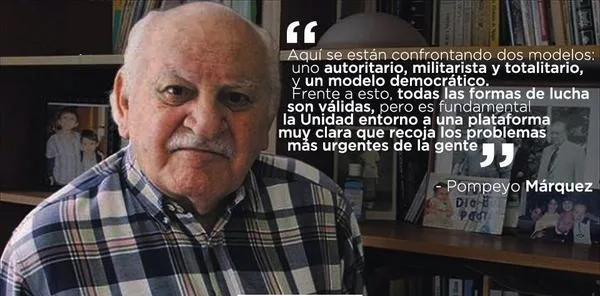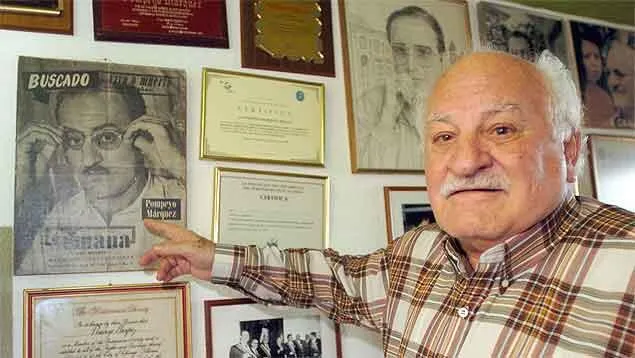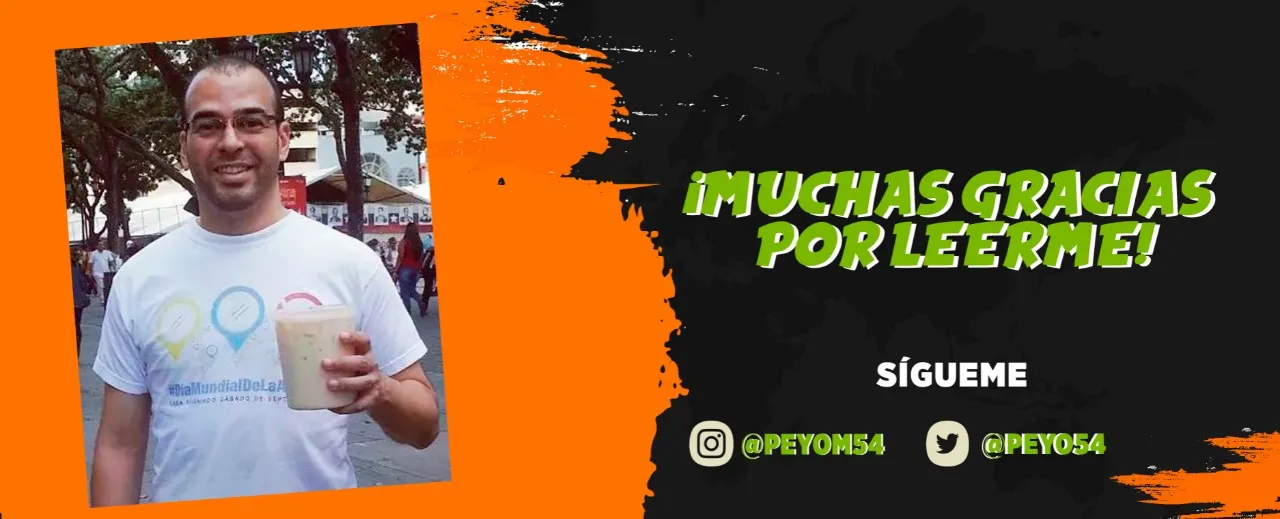TEXTO AUTOBIOGRAFICO DE MI ABUELO POMPEYO MARQUEZ "MI VOCACION PERIODISTICA"
Versión español
Hola Hivers,
AUTOBIOGRAPHICAL TEXT OF MY GRANDFATHER POMPEYO MARQUEZ "MY JOURNALISTIC VOCATION"
English version
Hello Hivers,
Como lo expresé en mi presentación en aras de rendirle un homenaje póstumo a mi querido abuelo Pompeyo Márquez compartiendo sus vivencias e interesantes escritos que al traducirlos al inglés y compartirlos en tan distinguida comunidad reafirmo la esperanza de que lleguen a muchísimas más personas en el mundo.
En esta oportunidad es propicio publicar un texto autobiográfico que detalla su vocación como periodista.
Así empieza…
Mi vocación periodística se remonta a 1937 y 1938, cuando me inicié en las publicaciones "Masas", "Juventud", "El Trabajo", y "El Sanjuanero", que me llevaron hacia el "Ultimas Noticias".
Trabajaban en ese diario Oscar Yánez y Raúl Domínguez como reporteros estrellas. Pedro Beroes, Kotepa Delgado y Simone De Lima, me asignaron como tarea localizar las células nazis que funcionaban en Caracas. Me dediqué a perseguir al dueño de la Tipografía Americana, quien era señalado como Nazi. El seguimiento era en tranvía. Después de varios días ¡Eureka!, localicé una reunión en el sector de El Cementerio. Llamé al fotógrafo. Se tomaron fotos de la casa y salió mi primer trabajo como reportero.
El PCV editaba un semanario de lujo, "¡Aquí está!"!, donde se desempeñaban como directores Miguel Otero Silva, Carlos Augusto León y Ernesto Silva Tellería. Allí se publicó mi primer reportaje, precisamente a mi regreso de El Callao, que relataba las condiciones de vida y de trabajo de los trabajadores de las minas del oro.
Me dieron los « honores» de publicarlo en la contraportada del periódico. Ernesto me llamó para que me desempeñara como administrador y además me encargan de una página semanal sobre problemas municipales
On this occasion it is appropriate to publish an autobiographical text detailing his vocation as a journalist.
This is how it begins...
My vocation as a journalist dates back to 1937 and 1938, when I started working for the publications "Masas", "Juventud", "El Trabajo", and "El Sanjuanero", which led me to the headquarters of the newspaper "Ultimas Noticias".
Oscar Yánez and Raúl Domínguez worked there as star reporters. Pedro Beroes, Kotepa Delgado and Simone De Lima assigned me the task of tracking down the Nazi cells operating in Caracas. I devoted myself to chasing the owner of the Tipografía Americana, who was identified as a Nazi. The pursuit was by tram. After several days, Eureka! I located a meeting in the "El Cementerio" sector.
I called the photographer. Pictures were taken of the house and my first job as a reporter came out.
The PCV Venezuelan Communist Party (PCV Partido Comunista Venezolano) published a luxury weekly, "¡Aquí está!", with Miguel Otero Silva, Carlos Augusto León and Ernesto Silva Tellería as editors. It was there that my first report was published, precisely on my return from El Callao, which described the living and working conditions of the workers in the gold mines.
I was given the "honours" of publishing it on the back page of the newspaper. Ernesto called me to take on the role of administrator and I was also put in charge of a weekly page on municipal problems.

Llegó 1943 y se preparaba la edición 00 del diario "El Nacional". Iba con mucha frecuencia al local de Marcos Parra a Solís, ubicado muy cerca del local de Unión Municipal situado de Muñoz a Solís. Miguel Otero Silva me llamó para ofrecerme 300 bolívares como reportero, pero el viejo Otero me invitó a conversar con él y me ofreció encargarme de la distribución del periódico con un sueldo de 600 bolívares. Ya Juan Molina estaba empleado, meses antes de aparecer el primer número. Yo comencé dos meses antes.
Seguía distribuyendo el semanario "El Morrocoy Azul", cargo que asumió Rafael Octavio Jiménez al salir "El Nacional". Rafael Octavio fue un compañero de largas luchas hasta su muerte. Llegó a ser designado Secretario de Propaganda del Comité Regional del PCV de Caracas y yo a su lado. Además, Rafael Octavio y yo teníamos en común que esperábamos a nuestras respectivas novias, ambas estudiantes de normal, en la Institución Educativa Gran Colombia. Eran Trina Melean y Socorro Negretti, con quienes contrajimos luego matrimonio.
Esa amistad y compañerismo se puso luego de manifiesto siendo Senadores, Rafael Octavio electo en las planchas de AD y yo en las del PCV. En plena polémica de los años 60 presenté una moción que necesitaba apoyo. Jesús Faría había salido cuando el presidente del Senado pregunta: "¿tiene apoyo?" Vi a mis colegas mudos y entonces Rafael Octavio se levanta y grita desde su curul ubicado al fondo del hemiciclo: "¡Sí, tiene apoyo!" Hoy sostengo una relación muy fraterna con su hijo, Rafael Simón Jiménez, quien desde los 13 años militaba en la Juventud Comunista y fue alto dirigente del MAS y primer vicepresidente de la Asamblea Nacional.
El 3 de agosto de 1943 salió a la calle el periódico "El Nacional". Se convirtió en un gran centro de divulgación democrática con Antonio Arraiz, Miguel Otero y José Moradell al frente de un equipo que ha hecho escuela y sacerdocio del periodismo.
Con lo poco que había ahorrado desde "El Morrocoy Azul" y con un sueldo aceptable, más lo que ganaba mi esposa Socorro como maestra normalista, decidimos casarnos el 3 de setiembre de 1943 fecha que casualmente 34 años después coincidiría con el nacimiento de mi nieto y homónimo Pompeyo Márquez.. Recuerdo que el viejo Otero me dijo: «bueno, pero no te doy más de dos días de luna de miel». Así fue.
Mi horario de trabajo era de 1 de la madrugada a las 8 de la mañana. A veces, por las largas discusiones fraccionales en el PCV, salía directamente de las reuniones partidistas al trabajo.
Era un momento de muchas dificultades para conseguir papel. El limitado número de ejemplares que se podían editar de El Nacional, generaba una verdadera pelea entre los propios pregoneros y entre los pregoneros y yo a la hora de la distribución. Dos veces tuve que imponerme a puño limpio ante los pregoneros que gritaban y agredían de palabra.
Conocí a una persona que desde aquel entonces era pura alegría y bondad, Juan Quijano, responsable de empaquetar el diario para su envío al interior del país. Juan devino luego en uno de los mejores reporteros gráficos del país.
Por el trabajo madrugador desfilaba conmigo Malaquías García, quien junto con su esposa Margot Castro fue uno de mis puntales durante la clandestinidad de Pérez Jiménez. Su casa, durante más de 8 años, fue sitio cálido y fraterno de encuentro con mi familia y en momentos muy difíciles de reunión del Buró Político. Asimismo, trabajó conmigo Alberto Consoño, a quien apodábamos La Madama, compañero de "La Pandilla Guirirí" de Potrerito de la cual formaban parte Eloy Torres, Ravelo, "El Tranvía", "el viejo" Chucho, Márquez, Jesús Esteves y otros.
Este fue un grupo muy singular. Tenía su punto de encuentro en Potrerito, cerca de El Calvario y en él se formó un equipo de béisbol llamado "Los Pingüinos". Era emocionante la solidaridad que teníamos para identificarnos: un silbido con una canción que entonaba el «alerta comunista». Salvo Malaquías y Consoño, los demás integrantes no eran del PCV, pero simpatizaban.
Creamos una amistad a toda prueba y para todos los tiempos. También fue conmovedor la manera como me rodearon y se solidarizaron en la clandestinidad.
I was still distributing the French-style newspaper "El Morrocoy Azul", a position that Rafael Octavio Jiménez took over when "El Nacional" came out. Rafael Octavio was a companion of long struggles until his death. He became the Propaganda Secretary of the Caracas Regional Committee of the PCV and I was at his side. Besides, Rafael Octavio and I had in common that we were waiting for our respective girlfriends, both students of normal school, in the Educational Institution "Gran Colombia". They were Trina Melean and Socorro Negretti, whom we later married. This friendship and comradeship was later manifested when we were Senators, Rafael Octavio elected on the AD (Acción Democrática) ticket and I on the PCV ticket.
In the midst of the controversy of the 1960s, I presented a motion that needed support. Jesús Faría had left when the president of the Senate asked: "Do you have support?" I saw my colleagues mute and then Rafael Octavio stood up and shouted from his seat at the back of the chamber: "Yes, he has support! Today I have a very fraternal relationship with his son, Rafael Simón Jiménez, who from the age of 13 was a militant in the Communist Youth and was a senior leader of MAS and first vice-president of the National Assembly.
On 3 August 1943 the newspaper "El Nacional" hit the streets. It became a great centre of democratic dissemination with Antonio Arraiz, Miguel Otero and José Moradell at the head of a team that became a school and a priesthood of journalism.
With the little I had saved from "El Morrocoy Azul" and with an acceptable salary, plus what my wife Socorro earned as a teacher, we decided to get married on 3 September 1943, date which coincidentally 34 years later would coincide with the birth of my grandson and namesake Pompeyo Márquez. I remember that old Otero said to me: "OK, but I won't give you more than two days for your honeymoon". And so it was.
My working hours were from 1 am to 8 am. Sometimes, because of the long factional discussions in the VCP, I went straight from party meetings to work.
It was a time of great difficulty to get paper. The limited number of copies of El Nacional that could be published generated a real fight between the criers themselves and between me and the criers when it came to distribution. Twice I had to impose myself with my bare hands against the town criers who shouted and shouted back and forth.
I met a person who from then on was pure joy and kindness, Juan Quijano, who was responsible for packing the newspaper for delivery to the interior of the country. Juan later became one of the best photojournalists in the country.
Malaquías García, who together with his wife Margot Castro was one of my mainstays during the Pérez Jiménez clandestine period, would parade with me through the early morning work. For more than eight years, his house was a warm and fraternal meeting place for my family and, at very difficult times, for the Political Bureau. Alberto Consoño, whom we nicknamed "La Madama", worked with me. He was a member of the "La Pandilla Guirirí" of Potrerito, which included Eloy Torres, Ravelo, "El Tranvía", "el viejo" Chucho, Márquez, Jesús Esteves and others. This was a very unique group. It had its meeting point in Potrerito, near El Calvario, and a baseball team called "Los Pingüinos" was formed. It was exciting the solidarity we had to identify ourselves: a whistle with a song that intoned the "communist alert". Except for Malaquías and Consoño, the other members were not PCV, but they sympathised.
We created a friendship that was foolproof and for all times. It was also touching how they surrounded me and showed solidarity with me in the underground.

Translation of the message of the first photo…
"Models are being confronted here:
An authoritarian, militaristic and totalitarian one, and a** democratic** one.
In the face of this, all forms of struggle are valid, but is fundamental The Unity around a very clear platform that takes up the most urgent problems of the people ".
Pompeyo Márquez


- 100% contenido original / 100% original content.
- Traducción realizada con DeepL / Translation made with DeepL.
- Fotos utilizadas en la publicación de mi exclusiva propiedad / Photos used in the publication of my exclusive property.

